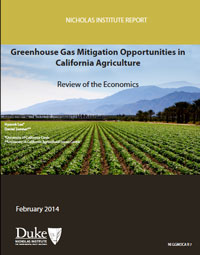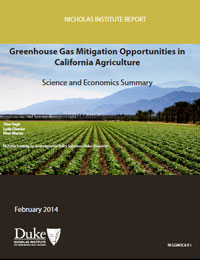Publications
Enhancing Compliance Flexibility under the Clean Power Plan: A Common Elements Approach to Capturing Low-Cost Emissions Reductions
As states and stakeholders evaluate compliance options under the U.S. Environmental Protection Agency’s proposed Clean Power Plan, many recognize the potential economic benefits of market-based strategies. In some states, however, market approaches trigger administrative and political hurdles. A new policy brief by the Nicholas Institute for Environmental Policy Solutions offers a compliance pathway that allows states to realize the advantages of multistate and market-based solutions without mandating either strategy. With the common elements approach, states develop individual-state plans to achieve their unique emissions targets and give power plant owners the option to participate in cross-state emissions markets. Power plant owners can transfer low-cost emissions reductions between states whose compliance plans share common elements--credits defined the same way and mechanisms to protect against double counting. The common elements approach offers the following benefits: (1) allows cross-state credit transfers without states negotiating a formal regional trading scheme, (2) leaves compliance choices to power companies, (3) builds on existing state and federal trading programs, and (4) maintains the traditional roles of state energy and environmental regulators.
Author(s): Jonas Monast, Tim Profeta, Jeremy Tarr, and Brian Murray
The Most Important Current Research Questions in Urban Ecosystem Services
The urbanized world depends on ecosystem services--both inside and outside of city boundaries. Although investing in their provision will often be more cost-effective than response actions, such as treatment, restoration, and disaster response, ecosystem services do not play a prominent role in the formulation of urban policies, plans, and laws. In fact, many cities are experiencing declines of the ecosystems that sustain them. Halting and reversing these declines requires identification of pressing research needs in the area of urban ecosystem services. This article brings together the collective insights of lawyers, urban planners, ecologists, and economists on the most important research questions that should shape the future of scholarship in this area.
Why Water Markets Are Not Quick Fixes for Droughts in the Western United States
Because of the peculiar nature of water rights, we should look to market-based transactions as an economically efficient way to reallocate scarce water resources. Nevertheless, because of the need to untangle the hydrologic interconnectedness of water rights and the institutional connectedness of irrigators and delivery institutions in the West, transfers of water will always be expensive and time consuming. Whether municipalities purchase water from farmers and thus bear the transaction costs directly, or the private sector purchases agricultural water, bears the associated risk and transaction costs, and sells it on to municipalities, end users will inevitably pay higher prices for water. Droughts can focus public attention on the value of water and potentially increase willingness-to-pay prices that reflect the transaction costs of tangled western water markets.
Optimizing the Scale of Markets for Water Quality Trading
Allowing polluters to buy, sell or trade water-quality credits could significantly reduce pollution in river basins and estuaries faster and at a lower cost than requiring facilities to meet compliance costs on their own, a new Duke University led study finds. The scale and type of the trading programs, though critical, may matter less than just getting them started. The analysis in the journal Water Resources Research shows that water-quality trading of any kind can significantly lower the costs of achieving Clean Water Act goals.
Conditional Water Rights in the Western United States: Introducing Uncertainty to Prior Appropriation?
In the prior-appropriation water rights regimes that prevail in the arid western United States, claims to annually variable surface water flows are fulfilled on the basis of the order of their establishment. The two-step process used to establish an appropriative water right in all 17 conterminous western states creates a temporary phase, or conditional water right, that has a priority date but no actual water use. This article reviews the legal basis for these conditional water rights and demonstrates the potential uncertainty they introduce to current water users. It then presents a complete census of conditional water rights (amounts, ages, and uses) in Colorado. At the end of 2012, conditional water rights in Colorado (some over 90 years old) were equal to 61% of the perfected water rights. Many of the controversial conditional water rights in Colorado have been associated with unconventional oil production in the northwestern portion of the state; however, conditional water rights are ubiquitous across the state and across many use types. In several basins, their existence can introduce uncertainty to some of the most senior water rights holders. Nevertheless, in most of the state, the effects of conditional water rights are restricted to a relatively junior class of water users. This work quantifies for the first time the result, in one state, of a peculiar aspect of water law common across all western prior-appropriation states.
Land Use in a Future Climate Agreement
The second options assessment report, Land Use in a Future Climate Agreement, is in support of the ADP negotiations on a post-2020 agreement and focuses specifically on the role of emissions and removals from land use. It is part of a series of option reports funded by the U.S. Department of State but is not in support of, or reflecting, U.S. Government positions and is the sole work of an independent author team.
Refining Models for Quantifying the Water Quality Benefits of Improved Animal Management for Use in Water Quality Trading
Water quality trading (WQT) allows point-source permittees to meet their water quality obligations by purchasing credits from other point or nonpoint sources that have reduced their discharges. Improved management of animal operations could reduce nutrient discharges into waterways and thereby generate credits for WQT programs. But first, methods for quantifying pollutant reductions resulting from animal management changes must be adapted for use in such programs. This report explains the Clean Water Act underpinning of WQT programs and how animal operations fit into them. It surveys models of animal production of nutrient waste, surface water transport, and the transport and transformation of pollutants in watersheds. It also describes how direct measurement and monitoring of nutrient losses is evolving. Finally, it presents ideas on how to improve models’ accuracy and usability. The report reflects insights from three supplemental papers: Management Practices to Improve Water Quality on Central and Western Rangelands, Assessing Potential Impacts of Livestock Management on Groundwater, and Management Options for Animal Operations to Reduce Nutrient Loads.
Greenhouse Gas Mitigation Opportunities in California Agriculture: Science and Economics Summary
California Assembly Bill 32 requires effective statewide greenhouse gas (GHG) reduction strategies. This report summarizes the results of six studies--developed to inform California policy--that review the latest science and economics of GHG mitigation opportunities in California's agricultural sector. Specifically, the report examines the potential for annual GHG reductions in cropland, rangeland, and manure management systems and through emissions-targeted optimization of feed for dairy animals. Among the examined practices, dairy manure management appears to provide the largest emissions reduction opportunity at the lowest cost per ton, but economic and other hurdles must be overcome to realize it. Other mitigation activities could yield relatively large per-acre reductions but on relatively small acreage. Yet other activities could be widely implemented, but their potential effectiveness is uncertain. More data on the GHG reduction potential and costs of management practices in California agriculture and a better understanding of adoption barriers are needed.
Greenhouse Gas Mitigation Opportunities for California Agriculture: Review of the Economics
Although about three-quarters of California farm revenue derives from crop production, crops—mainly tree, vine, and vegetable crops—account for only about one-quarter of GHG emissions. Some studies indicate minimal yield loss from reducing nitrogen fertilizer use, and simulation results show significant percentage reductions in GHG emissions for payments of $20/MTCO2e. The economics of reducing emissions from enteric fermentation has been little studied. Manure management to reduce GHG emissions (mainly methane) can be as simple as covering manure lagoons and flaring methane. The more complex option of using manure-generated methane gas to replace fossil fuels has been investigated often. Most case studies and simulations suggest this option is costly. Its economic feasibility depends on specific local conditions, but there is no evidence of large-scale feasibility in California without large subsidies.
Greenhouse Gas Mitigation Opportunities for California Agriculture: Outlook for California Agriculture to 2030
California agriculture is diverse and complex, producing several dozen major crop and livestock commodities using the state’s great spatial variation of natural and climate resources and well-developed infrastructure of input delivery systems, processing systems, and marketing services. What, where, and how these commodities are produced reflect biophysical, economic, and policy drivers, all of which have and will continue to change. This report examines the statewide greenhouse gas (GHG) emissions and emissions mitigation potential of alternative futures for California agriculture through 2030. It finds that the dairy industry in California has by far the largest GHG emissions of all the state’s agricultural production systems but that the industry’s growth trajectory is uncertain. Three potential growth scenarios suggest that baseline dairy emissions could decrease by as much as 20% or increase by as much as 40% (almost one-quarter of the entire agricultural sector’s current emissions). This variation in baseline emissions projections may be as large as or larger than the industry’s emissions mitigation potential.










